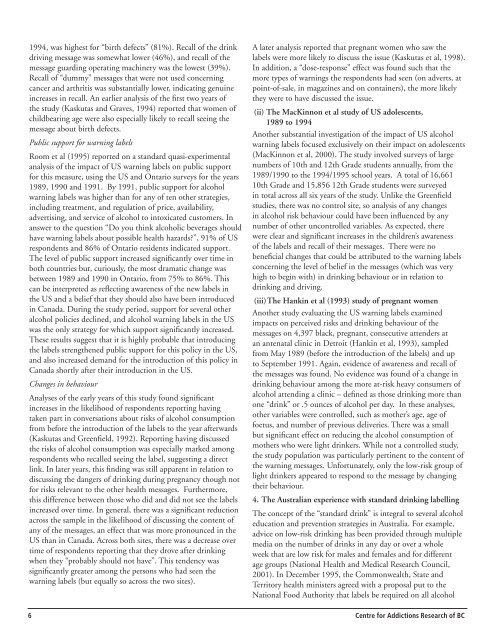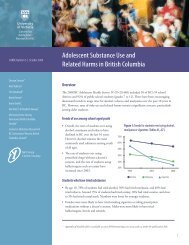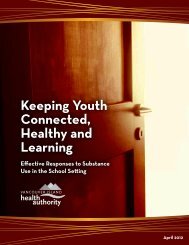A Review Of Research Into The Impacts Of Alcohol ... - CARBC
A Review Of Research Into The Impacts Of Alcohol ... - CARBC
A Review Of Research Into The Impacts Of Alcohol ... - CARBC
Create successful ePaper yourself
Turn your PDF publications into a flip-book with our unique Google optimized e-Paper software.
1994, was highest for “birth defects” (81%). Recall of the drink<br />
driving message was somewhat lower (46%), and recall of the<br />
message guarding operating machinery was the lowest (39%).<br />
Recall of “dummy” messages that were not used concerning<br />
cancer and arthritis was substantially lower, indicating genuine<br />
increases in recall. An earlier analysis of the first two years of<br />
the study (Kaskutas and Graves, 1994) reported that women of<br />
childbearing age were also especially likely to recall seeing the<br />
message about birth defects.<br />
Public support for warning labels<br />
Room et al (1995) reported on a standard quasi-experimental<br />
analysis of the impact of US warning labels on public support<br />
for this measure, using the US and Ontario surveys for the years<br />
1989, 1990 and 1991. By 1991, public support for alcohol<br />
warning labels was higher than for any of ten other strategies,<br />
including treatment, and regulation of price, availability,<br />
advertising, and service of alcohol to intoxicated customers. In<br />
answer to the question “Do you think alcoholic beverages should<br />
have warning labels about possible health hazards”, 91% of US<br />
respondents and 86% of Ontario residents indicated support.<br />
<strong>The</strong> level of public support increased significantly over time in<br />
both countries but, curiously, the most dramatic change was<br />
between 1989 and 1990 in Ontario, from 75% to 86%. This<br />
can be interpreted as reflecting awareness of the new labels in<br />
the US and a belief that they should also have been introduced<br />
in Canada. During the study period, support for several other<br />
alcohol policies declined, and alcohol warning labels in the US<br />
was the only strategy for which support significantly increased.<br />
<strong>The</strong>se results suggest that it is highly probable that introducing<br />
the labels strengthened public support for this policy in the US,<br />
and also increased demand for the introduction of this policy in<br />
Canada shortly after their introduction in the US.<br />
Changes in behaviour<br />
Analyses of the early years of this study found significant<br />
increases in the likelihood of respondents reporting having<br />
taken part in conversations about risks of alcohol consumption<br />
from before the introduction of the labels to the year afterwards<br />
(Kaskutas and Greenfield, 1992). Reporting having discussed<br />
the risks of alcohol consumption was especially marked among<br />
respondents who recalled seeing the label, suggesting a direct<br />
link. In later years, this finding was still apparent in relation to<br />
discussing the dangers of drinking during pregnancy though not<br />
for risks relevant to the other health messages. Furthermore,<br />
this difference between those who did and did not see the labels<br />
increased over time. In general, there was a significant reduction<br />
across the sample in the likelihood of discussing the content of<br />
any of the messages, an effect that was more pronounced in the<br />
US than in Canada. Across both sites, there was a decrease over<br />
time of respondents reporting that they drove after drinking<br />
when they “probably should not have”. This tendency was<br />
significantly greater among the persons who had seen the<br />
warning labels (but equally so across the two sites).<br />
<br />
A later analysis reported that pregnant women who saw the<br />
labels were more likely to discuss the issue (Kaskutas et al, 1998).<br />
In addition, a “dose-response” effect was found such that the<br />
more types of warnings the respondents had seen (on adverts, at<br />
point-of-sale, in magazines and on containers), the more likely<br />
they were to have discussed the issue.<br />
(ii) <strong>The</strong> MacKinnon et al study of US adolescents,<br />
1989 to 1994<br />
Another substantial investigation of the impact of US alcohol<br />
warning labels focused exclusively on their impact on adolescents<br />
(MacKinnon et al, 2000). <strong>The</strong> study involved surveys of large<br />
numbers of 10th and 12th Grade students annually, from the<br />
1989/1990 to the 1994/1995 school years. A total of 16,661<br />
10th Grade and 15,856 12th Grade students were surveyed<br />
in total across all six years of the study. Unlike the Greenfield<br />
studies, there was no control site, so analysis of any changes<br />
in alcohol risk behaviour could have been influenced by any<br />
number of other uncontrolled variables. As expected, there<br />
were clear and significant increases in the children’s awareness<br />
of the labels and recall of their messages. <strong>The</strong>re were no<br />
beneficial changes that could be attributed to the warning labels<br />
concerning the level of belief in the messages (which was very<br />
high to begin with) in drinking behaviour or in relation to<br />
drinking and driving.<br />
(iii) <strong>The</strong> Hankin et al (1993) study of pregnant women<br />
Another study evaluating the US warning labels examined<br />
impacts on perceived risks and drinking behaviour of the<br />
messages on 4,397 black, pregnant, consecutive attenders at<br />
an antenatal clinic in Detroit (Hankin et al, 1993), sampled<br />
from May 1989 (before the introduction of the labels) and up<br />
to September 1991. Again, evidence of awareness and recall of<br />
the messages was found. No evidence was found of a change in<br />
drinking behaviour among the more at-risk heavy consumers of<br />
alcohol attending a clinic – defined as those drinking more than<br />
one “drink” or .5 ounces of alcohol per day. In these analyses,<br />
other variables were controlled, such as mother’s age, age of<br />
foetus, and number of previous deliveries. <strong>The</strong>re was a small<br />
but significant effect on reducing the alcohol consumption of<br />
mothers who were light drinkers. While not a controlled study,<br />
the study population was particularly pertinent to the content of<br />
the warning messages. Unfortunately, only the low-risk group of<br />
light drinkers appeared to respond to the message by changing<br />
their behaviour.<br />
4. <strong>The</strong> Australian experience with standard drinking labelling<br />
<strong>The</strong> concept of the “standard drink” is integral to several alcohol<br />
education and prevention strategies in Australia. For example,<br />
advice on low-risk drinking has been provided through multiple<br />
media on the number of drinks in any day or over a whole<br />
week that are low risk for males and females and for different<br />
age groups (National Health and Medical <strong>Research</strong> Council,<br />
2001). In December 1995, the Commonwealth, State and<br />
Territory health ministers agreed with a proposal put to the<br />
National Food Authority that labels be required on all alcohol<br />
Centre for Addictions <strong>Research</strong> of BC





